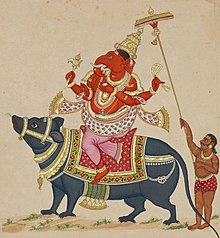Ganesha
 The image of Ganesha is one of the most distinctive ones within Hinduism. The image has an elephant's head and a large human body usually colored pink or yellow. The elephant's head symbolizes the gaining of knowledge through listening (ears) and reflection (large head). The two tusks, one whole and the other broken, reflect the existence of perfection and imperfection in the physical world. There is a wealth of symbolism associated with his 'pot belly'. It has been interpreted as reflecting an ability to digest whatever experiences life brings. It may also be seen as a sign of well-being and of his role as a provider of earthly riches. Ganesha is shown with one leg on the ground and the other one folded as if he were meditating. This reflects a balance between the practical and spiritual life, a theme which is repeated in the symbolism of some of the objects associated with him.
The image of Ganesha is one of the most distinctive ones within Hinduism. The image has an elephant's head and a large human body usually colored pink or yellow. The elephant's head symbolizes the gaining of knowledge through listening (ears) and reflection (large head). The two tusks, one whole and the other broken, reflect the existence of perfection and imperfection in the physical world. There is a wealth of symbolism associated with his 'pot belly'. It has been interpreted as reflecting an ability to digest whatever experiences life brings. It may also be seen as a sign of well-being and of his role as a provider of earthly riches. Ganesha is shown with one leg on the ground and the other one folded as if he were meditating. This reflects a balance between the practical and spiritual life, a theme which is repeated in the symbolism of some of the objects associated with him.In his hands he holds such objects as a rope or noose, to trap the things which attract the mind to the world, and a goad or iron hook, to represent the need to control desires. But he is also typically shown with a bowl of sweetmeats representing earthly prosperity and well-being. He may also be shown with an axe or trident, both of which link him with Shiva. Other symbolic objects which may be associated with Ganesha are a shell, water lily, mace and discus.
He is pictured with four arms symbolizing such aspects of Hinduism as the four Vedas (ancient sacred books), the four aims of Hinduism and the four stages of life.
His vehicle is a rat or a mouse as these creatures are known for their ability to gnaw through barriers. The combination of the elephant and the rat or mouse ensures that all obstacles, of whatever size, are removed. The fact that a rat/mouse and food are often shown around or under his feet has also been interpreted as reflecting the idea that desires and wealth are both under his control.
Ganesha is worshiped as the deity who removes barriers and bestows wisdom and good fortune. Many Hindus have an image of Ganesha on their shrines and pray to him before they begin their worship of other deities. He is also worshiped at the beginning of any new venture such as a wedding or the building of a new house. Ganesha is often shown with an open hand, palms upturned, sometimes holding a gift to show him granting favors to his devotees.
As god of wisdom he is invoked at the beginning of books and may be shown holding a tusk as a pen since he is regarded as the writer of the scriptures and hence the patron of schools and of the written word.
In Hindu mythology Ganesha is identified as the son of Shiva and Parvati. The stories about the loss of his head all tend to agree that it was replaced by that of the first living animal that came along, which was an elephant.
